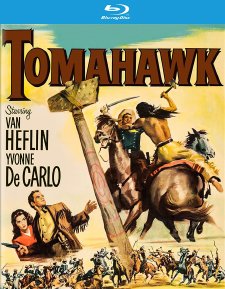Tomahawk (1951) (Blu-ray Review)

Director
George ShermanRelease Date(s)
1951 (March 28, 2023)Studio(s)
Universal-International (Kino Lorber Studio Classics)- Film/Program Grade: B+
- Video Grade: A
- Audio Grade: A-
- Extras Grade: B-
Review
A pleasant surprise, Tomahawk (1951) is an above-average Western almost certainly prompted by the big critical and commercial successes of John Ford’s Fort Apache (1948) and Delmer Daves’s Broken Arrow (1950), the latter earning an impressive $3.6 million in U.S. rentals. Those films were among the first major Hollywood movies to humanize Native Americans, to dramatize the many injustices committed against them by the government and brutality by bloodthirsty racists within the U.S. Cavalry particularly.
George Sherman, the director of Tomahawk, was no Ford or Daves, but the film is unusually good, with a degree of historical verisimilitude rare for the period, and headlined by a strong performance by star Van Heflin. Further, the video transfer of this three-strip Technicolor production (photographed by Charles P. Boyle) is excellent, rendering the negative reviews I’ve seen elsewhere of both the film and the transfer puzzling to say the least.
In 1866 Wyoming, U.S. Army officials are meeting with Sioux chiefs including Red Cloud (John War Eagle) to negotiate a new treaty—in reality, once again the government blithely plans on violating the terms of an earlier treaty now that gold has been discovered in Montana, is anxious to open a new trail through the middle of Sioux territory, and already has secretly built Fort Phil Kearny there.
Scout and fur trader Jim Bridger (Heflin) rides 200 miles to propose an alternative route that avoids Sioux territory entirely while adding a mere two additional days for supply trains. The Indians respect Bridger’s efforts, but it’s clear the Army cannot be trusted.
Col. Carrington (Preston Foster), commander of the new fort, offers Bridger and his partner, Sol Beckworth (Jack Oakie), jobs as scouts, but Bridger declines until among Carrington’s men Monahseetah (Susan Cabot), Bridger’s Indian ward (whom everyone mistakes for his wife) spots Lt. Rob Dancy (Alex Nicol), whom Bridger suspects of participating in a massacre of an entire Indian village. Later, while escorting vaudevillians Dan Castello (Tom Tully) and his beautiful niece, Julie (Yvonne De Carlo), Dancy shoots dead a teenage Sioux in cold blood and covers up the murder. Soon after the Sioux in retaliation critically wound Castello with an arrow.
Carrington respects Bridger’s experience and good sense but the soldiers, anxious to “see some action,” are irritated by Bridger’s presence, denouncing him as a “squaw man” and possible spy, anger fueled by Dancy and Capt. Fetterman (Arthur Space). Dancy’s willingness to disobey direct orders and goading of Fetterman soon spell disaster for all.
Much of Tomahawk is fact-based. Bridger, Carrington, Red Cloud, and Fetterman were all real people, and even Oakie’s character, Sol Beckworth, was based on another real-life mountain man, James Beckwourth. Fort Phil Kearny was an actual U.S. Army fort, and the film recreates two significant Indian Wars battles, the Fetterman Fight (a disastrous precursor to Little Big Horn) and the Wagon Box Fight, both pretty accurately recreated by 1950s Hollywood standards, and a significant portion of the film was shot on location in South Dakota, adding to the verisimilitude. Further, except for Susan Cabot, all the Native American roles in the film are played by Native Americans.
In Tomahawk, the Indians bend over backward to avoid violent conflict, even after being repeatedly lied to by government officials. On the other hand, even the sympathetic Julie and the colonel’s wife (Ann Doran), the latter kindly teaching Monahseetah English, can’t hide their disapproval of what they imagine is a sexual relationship between Bridger and his “squaw.” The film’s only blatantly false note is its upbeat, optimistic ending.
Beefy, brooding Van Heflin was somewhat underrated as an actor. Part of his appeal here is how much his character observes, rather than simply advocate verbally Native American positions. He argues his points without emotion, isn’t very optimistic the Army will comply with his suggestions, nor does he get agitated when foolish choices are made. The screenplay by Silvia Richards (Rancho Notorious, Possessed) and Maurice Geraghty (Whiplash, RKO’s Falcon series) also resists making Dancy and Fetterman conventional antagonists; their racist attitudes were the rule rather than the exception, and their military ambitions are less overtly obsessive than, say, Custer’s were.
This was Rock Hudson’s fifth credited film role, though he’s virtually unrecognizable in his first scene, his face cheated away from the camera, and only clearly shown, briefly speaking a line or two, about an hour into the picture. The film cost just $750,000, not expensive for a Technicolor production partly shot far from Hollywood, and made $2 million in U.S. rentals, a solid hit.
Kino’s release of Tomahawk looks splendid. Filmed in three-strip Technicolor, primary colors really pop, especially reds and greens, and I spotted no misalignment issues. Presumably this transfer was derived from the original separation camera negatives and the image is also razor-sharp, even on my large projection screen. The DTS-HD Master Audio (2.0 mono) is also above average, and optional English subtitles are provided. Region “A” encoded.
An inferior-looking trailer (2:20) will give viewers some idea of what movies like Tomahawk looked like for decades on television and early home video. A new audio commentary track by Lee Gambin and actress Rutanya Alda (to clarify, she’s not in the film) is just okay, meandering but more film-focused than the one accompanying Border River, a simultaneous release from Kino.
I wasn’t expecting much from Tomahawk, particularly on the heels of the lackluster Border River, directed by George Sherman soon after, but the picture is well above average, and Western fans will be pleased.
- Stuart Galbraith IV

